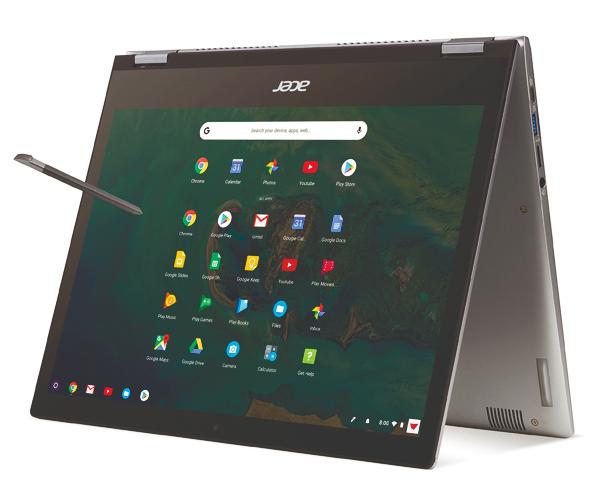GOOGLE, the maker of some of the most ubiquitous online services (Gmail), web browser (Chrome), and smartphone operating systems (Android), also makes a laptop operating system (Chrome OS).
Devices that use Chrome OS are called Chromebooks.
They come in many forms: laptops, convertible laptops, and tablets.
In addition to running the Chrome OS, Chromebooks are noted for their ability to withstand abuse, their modest specifications, and their affordable price tag.
This is because they are designed to be shared in an educational and enterprise settings.
Acer is the maker of the first-ever Chromebook.
One of its latest and greatest is the Acer Chromebook Spin 13.
Note that the Acer Chromebook Spin 13 is not a typical Chromebook.
It is designed to look good, has high-end specifications, and has a RM3,599 price tag.
It is not only one of the most premium Chromebooks in the market but also one of the best.
Chromebooks are devices that run the Chrome browser. It functions as a terminal for the browser, which means that if what you want to do can be done on a browser, it can be done on a Chromebook.
And there is a lot that you can do with just an internet browser.
When paired with Google’s suite of online services, a Chromebook gains all the essential productivity capabilities of a typical PC.
Google Drive provides cloud storage, and a productivity suite; Gmail provinces email services; Google Photos is a photo viewer, and so on.
This browser dependency also means that the Chromebook is mostly Internet dependent (although a lot of its functions are still available offline), easily managed in group settings, and can be shared (which is one of the most substantial advantages of this type of device).
But why I hear you ask, does the Acer Chromebook Spin 13 has a relatively high-end processor (Intel Core i5) if it is only going to run the Chrome browser?
Three years ago, Google began rolling out the ability for Chrome OS to run the Google Play Store.
This essentially gave the Chromebook access to Android’s library of apps and turned the device into an attractive alternative to tablets and laptops especially to us consumers.
The ability to run your favourite Android apps and games in a Chromebook increases its usefulness exponentially.
Because of the generous specifications on the Acer Chromebook Spin 13, it can run multiple Android apps and games just as good if not better than any premium Android phone can. And it does all that on a 13.3in, 2256-by-1504 display.
Remember when I said that Chromebooks are meant to be shared? Chromebooks are basically terminals.
They are mostly hardware shells used to access data and services online.
In practice, when you log into a Chromebook, you can customise it and load it up with all the apps and setting that you want, just like any device.
But, when you log off a Chromebook, all your setting will be stored in the cloud.
Log back into any other Chromebook that is connected to the internet, and you have the option to load the new Chromebook that you are using with all the same settings and apps that you had set up.
This ability to migrate between Chromebooks, and to use any Chromebook as your own makes Chromebooks especially useful in the education and enterprise sectors.
Let us take the example of a shared workspace environment.
Imagine that you do not even have to bring your own laptop. Just go to a shared workspace location, loan one of their Chromebooks and log in.
All your apps and setting will be there, no matter what Chromebook device you’re using.
Once you log off, all your configuration will be wiped clean, and you can return the device knowing that no one else could have access to your data because it is already stored in the cloud.
Imagine the same thing but in a school or office setting and you can see the value of Chromebook.
In a household, a Chromebook or multiple Chromebooks can be shared between family members.
For a single user, a Chromebook can be an affordable large screen alternative to watch TV shows and play Android games on.
Of course, the Acer Chromebook Spin 13 can do a little bit more than that. It has a 3:2 aspect ratio high-resolution display that makes it ideal for reading books, magazines, websites, social feeds, and comics.
Pair the Acer Active Pen with its powerful performance, and you also get a responsive digital pad for notes, drawings, and doodles. I know it sounds novel, but trust me, it can be handy.
There are several Chromebook makers. However, Acer is one of the only few that brings its latest and greatest Chromebook offerings to the Malaysian market.
Intrigued?
Check out Acer’s online store and also take a look at its Acer Chromebook Tab 10 (RM1,399) and Acer Chromebook Spin 11 CP311 (RM1,499 – RM1,899).









